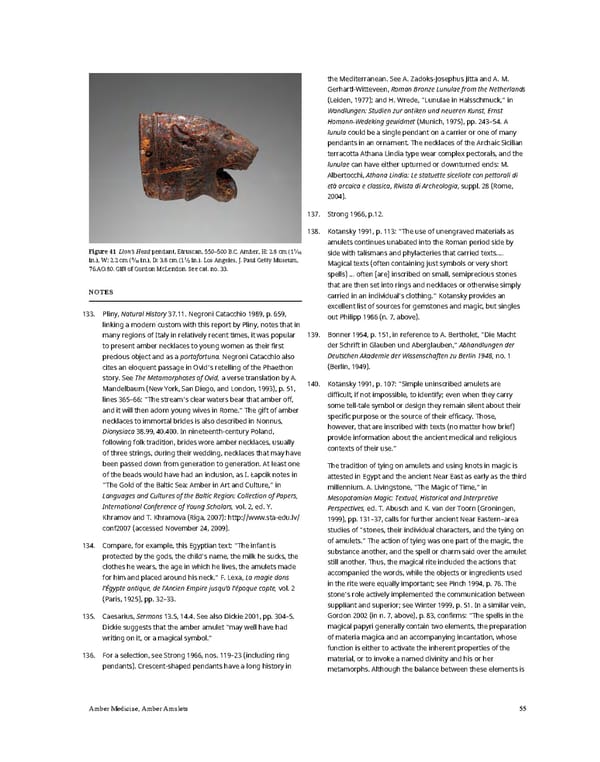the Mediterranean. See A. Zadoks-Josephus Jitta and A. M. Gerhartl-Witteveen, Roman Bronze Lunulae from the Netherlands (Leiden, 1977); and H. Wrede, “Lunulae in Halsschmuck,” in Wandlungen: Studien zur antiken und neueren Kunst, Ernst Homann-Wedeking gewidmet(Munich, 1975), pp. 243–54. A lunula could be a single pendant on a carrier or one of many pendants in an ornament. The necklaces of the Archaic Sicilian terracotta Athana Lindia type wear complex pectorals, and the lunulae can have either upturned or downturned ends: M. Albertocchi, Athana Lindia: Le statuette siceliote con pettorali di età arcaica e classica, Rivista di Archeologia, suppl. 28 (Rome, 2004). 137. Strong 1966, p.12. 138. Kotansky 1991, p. 113: “The use of unengraved materials as amulets continues unabated into the Roman period side by Figure 41 Lion’s Head pendant, Etruscan, 550–500 B.C. Amber, H: 2.8 cm (11⁄10 side with talismans and phylacteries that carried texts.… in.), W: 2.2 cm (9⁄10 in.), D: 3.8 cm (11⁄2 in.). Los Angeles, J. Paul Getty Museum, Magical texts (often containing just symbols or very short 76.AO.80. Gift of Gordon McLendon. See cat. no. 33. spells) … often [are] inscribed on small, semiprecious stones that are then set into rings and necklaces or otherwise simply NOTES carried in an individual’s clothing.” Kotansky provides an excellent list of sources for gemstones and magic, but singles 133. Pliny, Natural History 37.11. Negroni Catacchio 1989, p. 659, out Philipp 1986 (n. 7, above). linking a modern custom with this report by Pliny, notes that in many regions of Italy in relatively recent times, it was popular 139. Bonner 1954, p. 151, in reference to A. Bertholet, “Die Macht to present amber necklaces to young women as their first der Schrift in Glauben und Aberglauben,” Abhandlungen der precious object and as a portafortuna. Negroni Catacchio also Deutschen Akademie der Wissenschaften zu Berlin 1948, no. 1 cites an eloquent passage in Ovid’s retelling of the Phaethon (Berlin, 1949). story. See The Metamorphoses of Ovid, a verse translation by A. 140. Kotansky 1991, p. 107: “Simple uninscribed amulets are Mandelbaum (New York, San Diego, and London, 1993), p. 51, difficult, if not impossible, to identify; even when they carry lines 365–66: “The stream’s clear waters bear that amber off, some tell-tale symbol or design they remain silent about their and it will then adorn young wives in Rome.” The gift of amber specific purpose or the source of their efficacy. Those, necklaces to immortal brides is also described in Nonnus, however, that are inscribed with texts (no matter how brief) Dionysiaca 38.99, 40.400. In nineteenth-century Poland, provide information about the ancient medical and religious following folk tradition, brides wore amber necklaces, usually contexts of their use.” of three strings, during their wedding, necklaces that may have been passed down from generation to generation. At least one The tradition of tying on amulets and using knots in magic is of the beads would have had an inclusion, as I. Łapcik notes in attested in Egypt and the ancient Near East as early as the third “The Gold of the Baltic Sea: Amber in Art and Culture,” in millennium. A. Livingstone, “The Magic of Time,” in Languages and Cultures of the Baltic Region: Collection of Papers, Mesopotamian Magic: Textual, Historical and Interpretive International Conference of Young Scholars, vol. 2, ed. Y. Perspectives, ed. T. Abusch and K. van der Toorn (Groningen, Khramov and T. Khramova (Riga, 2007): http://www.sta-edu.lv/ 1999), pp. 131–37, calls for further ancient Near Eastern–area conf2007(accessed November 24, 2009). studies of “stones, their individual characters, and the tying on 134. Compare, for example, this Egyptian text: “The infant is of amulets.” The action of tying was one part of the magic, the protected by the gods, the child’s name, the milk he sucks, the substance another, and the spell or charm said over the amulet clothes he wears, the age in which he lives, the amulets made still another. Thus, the magical rite included the actions that for him and placed around his neck.” F. Lexa, La magie dans accompanied the words, while the objects or ingredients used l’Égypte antique, de l’Ancien Empire jusqu’à l’époque copte, vol. 2 in the rite were equally important; see Pinch 1994, p. 76. The (Paris, 1925), pp. 32–33. stone’s role actively implemented the communication between suppliant and superior; see Winter 1999, p. 51. In a similar vein, 135. Caesarius, Sermons 13.5, 14.4. See also Dickie 2001, pp. 304–5. Gordon 2002 (in n. 7, above), p. 83, confirms: “The spells in the Dickie suggests that the amber amulet “may well have had magical papyri generally contain two elements, the preparation writing on it, or a magical symbol.” of materia magica and an accompanying incantation, whose function is either to activate the inherent properties of the 136. For a selection, see Strong 1966, nos. 119–23 (including ring material, or to invoke a named divinity and his or her pendants). Crescent-shaped pendants have a long history in metamorphs. Although the balance between these elements is Amber Medicine, Amber Amulets 55
 Ancient Carved Ambers in the J. Paul Getty Museum Page 64 Page 66
Ancient Carved Ambers in the J. Paul Getty Museum Page 64 Page 66